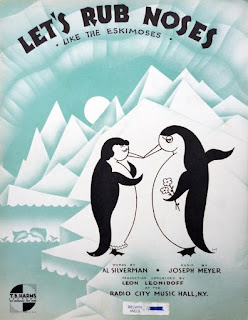The best part about that is you’d be picking the same person. For a good portion of time, both cartoon characters were played by Mae Questel.
Mae would turn 110 today were she still with us.
I’m not going to go through a list of “she did this, she did that.” She worked steadily for decades after winning a Helen Kane sound-alike contest in the late 1920s. If it wasn’t in radio, it was on the stage. If it wasn’t the stage, it was in movies. If it wasn’t movies, it was on TV.
Mae appeared in the ne plus ultra of vaudeville at the age of 21. She was in an act at The Palace with, of all people, New York Yankees pitcher Waite Hoyt in 1930. Later that year, she sang on a bill headlined by Helen Morgan. Still later that year, she wowed the reviewer for Billboard, who wrote of her October 22nd show at the Orpheum in New York:
Mae Questel, boop-boop-a-doop girl, went over like a house afire. Her impersonation of Irene Bordini mimicking Maurice Chevalier in song was eaten up. She sang this number in both French and English. Her delivery of I’m Dangerous Nan McGrew took the house by storm.In 1931, she appeared periodically on The Pleasure Hour on the NBC Blue network and that led to her own 15-minute show on NBC Red. The radio show she was on that I’d love to hear was on a March 1947 episode of CBS’ musical anthology series Once Upon a Tune. How’s this for an unbilled cast: Questel, Minerva Pious, Parker Fennelly, Everett Sloane and Arnold Stang!
Questel knew the real and fake Fanny Brice. Whether she played opposite the real one, I don’t know. But she played opposite the fake one in the movie “Funny Girl.” Questel talked about that and even some cartoon things in this story from the Tribune syndicate, October 22, 1968.
Betty Boop’s Alive, Well...Off the top of my head, I can’t pick a favourite performance by Questel in her many cartoons. She sang a fair number of enjoyable songs. If your Flash player will work in your browser, you can hear one at the bottom of this four-year-old post about her.
By STEPHANIE FULLER
Many Chicagoans who have heard Mae Questel over the years now have an opportunity to see her in “Funny Girl,” the movie currently playing in the United Artists theater.
“A number of people will overhear me talking in public, and say, ‘I know you. You’re . . . you’re . . . you’re . . .’ and then they keep trying to figure out why they know me,” she said. The problem is Mae hasn’t always been seen as well as heard.
Earlier in her career she created the voices for animated characters such as Olive Oyl, Little Lulu, Little Audrey, Casper the Friendly Ghost, and Betty Boop. “Paramount was looking for a girl with an unusual voice,” she recalls. “They picked me to do the Betty Boop cartoons in the early ‘30s. They took a caricature of me for the series.
“The process of animation has come a long way since then. If you recall, Betty didn’t have much facial expression.” Mae then screwed up her round face and went through Betty’s repertoire of expressions.
The actress, who has boundless energy and never is at a loss for conversation, plays the role of a friend of Fanny Brice’s mother in the movie. “Fanny Brice,” Mae said, her blue eyes getting misty. “Yes, I was lucky enough to know her. I even used to mimic her in cartoons.
“You know, Baby Snooks, which Fanny played on radio, came near the end of her career. The network contacted me and asked me to be ready to step in for her. However, her agent, William Morris, put his foot down. He maintained that Baby Snooks will always live with Fanny Brice, and he was right.”
Of the many people with whom Mae has worked, her closest friends were Sir Cedric Hardwicke because “he was charming, droll, and so witty,” and Gertrude Berg, the unforgettable “Molly Goldberg” with whom Mae played in “A Majority of One.”
“Of course, I knew Gertrude better than almost anyone I worked with because I worked with her the longest. She was a beautiful woman,” commented Mae, who only recently learned that Gertrude Berg left a letter in her will requesting that if her life story is done Mae will play the lead.
“The music is finished and the lyrics are completed for the story,” said Mae. “The story will center on Gertrude’s early life and tentatively is titled ‘Molly and Me.’
“It’s sad that the people we’ve mentioned aren’t here anymore,” she continued. “Time passes on. I think we are all so lucky if we can live to an age when we can look back, admire the milestones, and still enjoy what we’re doing. I love my work, and I have two sons of whom I’m extremely proud.”
Then Mae jumped up and did an imitation of her grand-daughter, Melissa, in a perfect 4-year-old’s voice saying, “You mean, Grandma, you mean you’re not going to see your picture with me?”
“Melissa is a complete ham,” she said. “At the drop of a hat she’ll get up and sing and dance.” Like grandmother, like granddaughter.





































